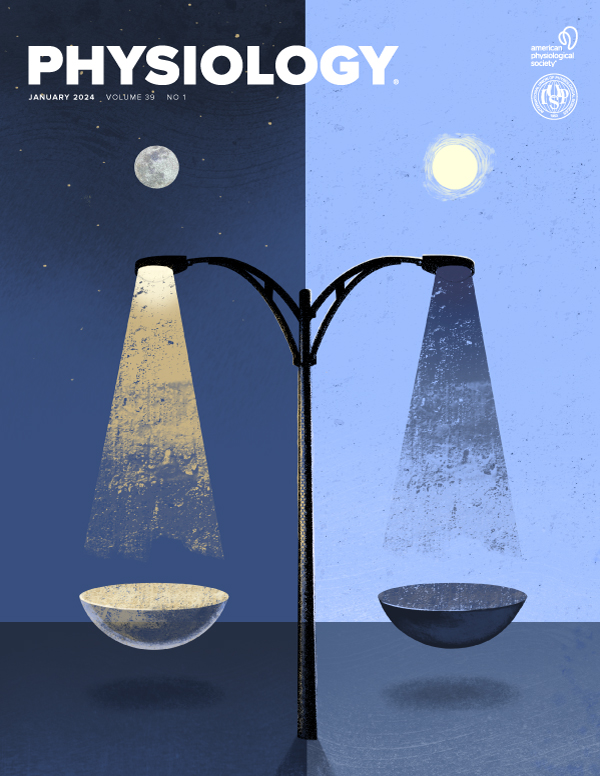胃饥饿素受体(GHSR)介导多巴胺对多巴胺2受体(D2R)的调节作用
IF 5.3
2区 医学
Q1 PHYSIOLOGY
引用次数: 0
摘要
多巴胺对中枢神经系统神经元多巴胺2受体(D2R)的典型作用是抑制作用,这种作用是通过g - αi/o通过GIRK通道介导的。然而,在腰骶脊髓的自主神经节前神经元和外侧下丘脑的两个部位,多巴胺通过D2R引起神经元兴奋。在这两个位置,多巴胺神经元被多巴胺激发,表达生长素受体GHSR。Ghrelin在外侧下丘脑和脊髓中缺失,有人提出Ghrelin可能通过形成异二聚体来调节D2R信号。在腰骶脊髓排便中枢神经元中,连续应用D2R和GHSR激动剂均具有兴奋性。GHSR对这些神经元的拮抗作用阻断了DR2刺激的兴奋作用,这也被细胞内钙(iCa2+)的消耗所阻断。我们在重组培养细胞中进一步研究了这种相互作用。在表达D2R的CHO细胞中,多巴胺激动剂对iCa2+几乎没有影响,而在GHSR存在的情况下,D2R与iCa2+偶联反应是对纳摩尔多巴胺的反应。D2R或GHSR拮抗均可降低多巴胺对D2R/GHSR细胞中iCa2+的升高,但GHSR激动剂的作用仅被GHSR拮抗所降低。GHSR存在时,D2R与iCa2+的偶联依赖于Gαq和Gαi/o,而ghrelin激动剂的偶联仅依赖于Gαq。D2R对cAMP的影响仅依赖于g - αi/o,不受GHSR拮抗作用的影响。荧光配体显示CHO细胞膜中的D2R和GHSR在高分辨率实时跟踪时独立移动,并且使用荧光寿命成像,单个标记的DR2位点距离不够近,无法检测共振能量转移(未检测到FRET)。与通过下游串扰耦合一致的是,在表达缺乏构成活性的GHSR - A204E突变体的细胞中,没有明显检测到DR2依赖的iCa2+。在这些细胞中,使用胃饥饿素阈下预刺激可以恢复dr2依赖性iCa2+的增加。在排便中枢的天然神经元中,响应D2R激动作用的内向电流被PLCβ抑制剂U73122阻断。综上所述,这些数据表明,在天然细胞和重组细胞中,多巴胺介导的兴奋依赖于GHSR、PLCβ和iCa2+。我们得出结论,在重组细胞和自主神经节前神经元群体中,GHSR的共表达导致激动剂诱导的、d2r介导的PLCβ激活和存储Ca2+释放的增强。D2R/GHSR细胞中D2R介导的兴奋同时依赖于Gαi/o和Gαq/11,但不需要受体二聚化。我们的研究结果揭示了gpcr之间在生理相关系统中的一种新的相互作用,这种相互作用不需要直接的受体相互作用,并且通过其他gpcr的调节对代谢性神经递质反应的重新编码具有广泛的意义。这是在2023年美国生理学峰会上发表的全文摘要,仅以HTML格式提供。此摘要没有附加版本或附加内容。生理学没有参与同行评议过程。本文章由计算机程序翻译,如有差异,请以英文原文为准。
Modulation of dopamine's effect at dopamine 2 receptors (D2R) mediated by association with the ghrelin receptor, GHSR
The typical action of dopamine at the dopamine 2 receptor (D2R) on CNS neurons is inhibition, an effect mediated via Gαi/o through GIRK channels. However, at two sites, autonomic preganglionic neurons in the lumbosacral spinal cord, and in the lateral hypothalamus, dopamine causes neuronal excitation through D2R. At both sites, dopamine neurons that are excited by dopamine express the ghrelin receptor, GHSR. Ghrelin is absent from the lateral hypothalamus and spinal cord, and it has been proposed that GHSR may modulate D2R signaling by the formation of heterodimers.In lumbrosacral spinal cord neurons of the defecation centre, D2R and GHSR agonists applied successively were both excitatory. Antagonism of GHSR at these neurons blocked the excitatory effect of DR2 stimulation, which was also blocked by depletion of intracellular calcium (iCa2+). We further investigated this interaction in recombinant cultured cells. In CHO cells expressing D2R, dopamine agonists had almost no effect on iCa2+, whereas in the presence of GHSR, D2R coupling to iCa2+ was observed in response to nanomolar dopamine. The elevation of iCa2+ by dopamine in D2R/GHSR cells was reduced by either D2R or GHSR antagonism, but the effect of a GHSR agonist was reduced only by GHSR antagonism. D2R coupling to iCa2+ in the presence of GHSR was dependent on both Gαq and Gαi/o, whereas ghrelin agonist coupling was dependent only on Gαq. D2R mediated effects on cAMP were dependent only on Gαi/o and were not effected by GHSR antagonism. D2R and GHSR in the membranes of CHO cells, revealed by fluorescent ligands, moved independently when tracked at high resolution in real time and, using fluorescent lifetime imaging, individual labelled DR2 sites were not in close enough proximity to detect resonance energy transfer (no detectable FRET). Consistent with coupling being via downstream crosstalk, no detectable DR2 dependent iCa2+ was evident in cells expressing the GHSR – A204E mutant, which lacks constitutive activity. The DR2-dependent iCa2+ increase was restored in these cells using subthreshold pre-stimulation with ghrelin. In native neurons of the defecation center, inward currents in response to D2R agonism were blocked by U73122, an inhibitor of PLCβ. Together this data indicates that dopamine-mediated excitation was dependent on GHSR, PLCβ and iCa2+, in both native and recombinant cells. We conclude that co-expression of GHSR causes augmentation of agonist-induced, D2R-mediated PLCβ activation and store Ca2+ release in recombinant cells and in a population of autonomic preganglionic neurons. D2R mediated excitation in D2R/GHSR cells is both Gαi/o and Gαq/11 dependent, but does not require receptor dimerisation. Our findings reveal a novel interaction between GPCRs, in a physiologically relevant system, that does not require direct receptor interaction and has broad implications for recoding of metabotropic neurotransmitter responses via modulation through other GPCRs. NHMRC grant, APP2012657, to SGBF This is the full abstract presented at the American Physiology Summit 2023 meeting and is only available in HTML format. There are no additional versions or additional content available for this abstract. Physiology was not involved in the peer review process.
求助全文
通过发布文献求助,成功后即可免费获取论文全文。
去求助
来源期刊

Physiology
医学-生理学
CiteScore
14.50
自引率
0.00%
发文量
37
期刊介绍:
Physiology journal features meticulously crafted review articles penned by esteemed leaders in their respective fields. These articles undergo rigorous peer review and showcase the forefront of cutting-edge advances across various domains of physiology. Our Editorial Board, comprised of distinguished leaders in the broad spectrum of physiology, convenes annually to deliberate and recommend pioneering topics for review articles, as well as select the most suitable scientists to author these articles. Join us in exploring the forefront of physiological research and innovation.
 求助内容:
求助内容: 应助结果提醒方式:
应助结果提醒方式:


